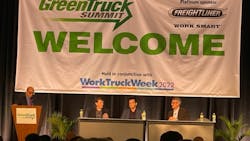Electrification at a 'tipping point' as fleets explore adoption
INDIANAPOLIS—There were naysayers and cheerleaders of fleet electrification all over the downtown convention center here on March 8. What they heard from stakeholders and early adopters during the various sessions of the Green Truck Summit is the e-truck future is coming; it’s just a question of whether adoption is right for your fleet.
The Freightliner-sponsored summit—which kicked off the larger exposition here, NTEA's Work Truck Week 2022, for light- and medium-duty vocational, utility, and municipal fleets—had attendees interested in electrification questioning their “use cases.” Or are they long-haul, regional, short-haul, last-mile fleets? Do their trucks haul heavy loads? Are electrified chassis best for them? (This is a concern for aerial- and bucket-truck operators.) Do the trucks function in more extreme weather? Is there equipment aboard that, if electrified, would shorten their vehicles’ range?
See also: The cost of a greener future for trucking
The attendees had a lot of advice coming at them—and lots of questions for stakeholders, who ranged on Tuesday from regulators (Liane Randolph, chairperson of the California Air Resources Board), “green-truck” advocates such as Paul Kokalis (president of upfitter Fontaine Modification and chairman of the Green Truck Association), OEM representatives (Daimler Truck North America's Steve Mignardi, VP of DTNA's on-highway market development, Alexander Voets, e-mobility product marketing and sales strategy manager, and Ray Eyles, Ford Pro’s Transit and E-Transit chief nameplate engineer), and hydrogen fuel-cell proponents such as Hyzon Motors CEO Craig Knight and George Rubin, Loop Energy’s chief commercial officer, who flew the banner during one session for hydrogen fuel-cell adoption.
It was sustainability that was really on their minds, as many attendees admitted. Welcoming remarks by Kokalis and Mignardi, moderated by MotorWeek producer and host John Davis, and the keynote speech by CARB’s Randolph, reminded them of the costs to the planet of a diesel-powered future but also of the definite business benefits of phasing in electric vehicles.
Getting after electrification—and its pace during the pandemic
“We are at the tipping point when it comes to transportation electrification,” said Mignardi of DTNA, an OEM that with Volvo is an early manufacturer of all-electric commercial vehicles in the Freightliner eCascadia Class 8 on-highway truck and the eM2 electric box truck. “It’s pretty exciting when you see something you’ve dreamed about come to reality.”
The question was posed to the speakers whether the last two years-plus of the COVID-19 pandemic had slowed the pace of trucking’s move toward electrification. The answer was an emphatic no.
Davis, who covers the light-duty industry, added: “When it comes to cleaner vehicles, we know a lot has changed in 24 months,” and that “there’s been little delay in clean-truck development during the pandemic. We’ve seen dramatic progress during the pandemic, and there’s more to come.”
See also: EPA proposes new truck emission standards
The driver toward electrification and other alternative fuels such as hydrogen fuel cell and biofuels, in part, is government regulation from the U.S. Environmental Protection Agency—the EPA’s latest action proposed this week would change the rules for the first time since 2001 by reducing NOx emissions from trucks by as much as 60% by 2045—and CARB out west.
In her keynote, Randolph noted CARB’s goal, set last summer by California Gov. Gavin Newsom, of full zero-emission vehicle (ZEV) sales by 2035 and a full transition, including used trucks, to 100% ZEVs by 2045.
“These are incredibly ambitious targets. Why? We face incredible emissions challenges,” Randolph said, noting that many areas in California, especially SoCal, exceed EPA smog limits and that the climate is starting to fight back, citing the multiple wildfires in the state as an example.
“Cleaning up the transportation sector will be key to addressing these challenges,” she said, noting that 6% of all vehicles in the state are trucks but that they account for 30% of the emissions there.
“Our goal is to have fewer and fewer of these diesel-burning trucks on the road,” Randolph added, noting another electrification statistic relevant to her audience at the summit: 500 makes and models of ZEVs, between Classes 2-8, are already available on the marketplace.
See also: Diesel price surge sets U.S. record
The audience during the question-and-answer session at her keynote aimed straight at the viability of electric vehicles in everyday trucking and vocational operations, as they would during later sessions.
Through moderator Davis, someone asked how government can ensure enough trucks would be available in the marketplace. Randolph noted that California’s Advanced Clean Truck regulation requires OEMs to manufacture the vehicles, so supply should not be an issue. “Manufacturers need to ensure they are selling into this market,” the CARB chair said.
In an answer to another question, she noted that “numerous” incentive programs exist in California, through CalStart and others, and more are cropping up nationwide.
“We’re not going to snap our fingers and there be all electric vehicles,” she said.
About the Author
Scott Achelpohl
Managing Editor
Scott Achelpohl is a former FleetOwner managing editor who wrote for the publication from 2021 to 2023. Since 2023, he has served as managing editor of Endeavor Business Media's Smart Industry, a FleetOwner affiliate.

